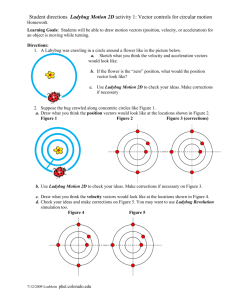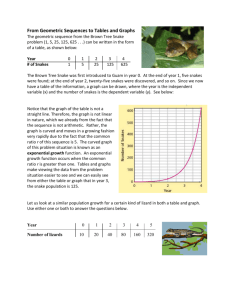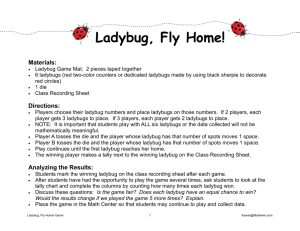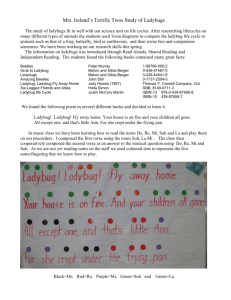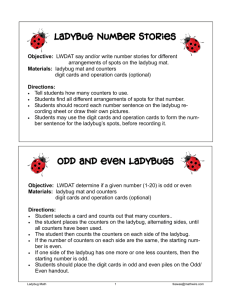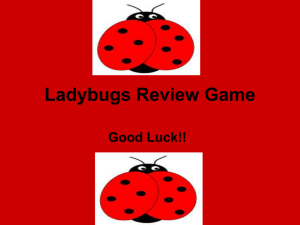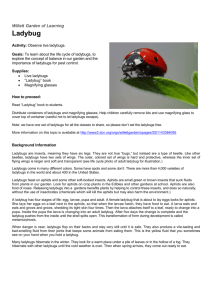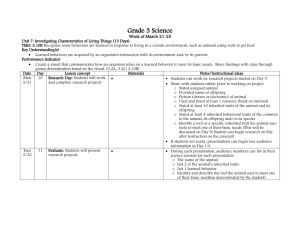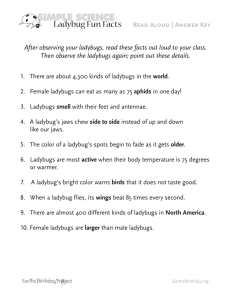lost ladybug project - Oregon State University Extension Service
advertisement
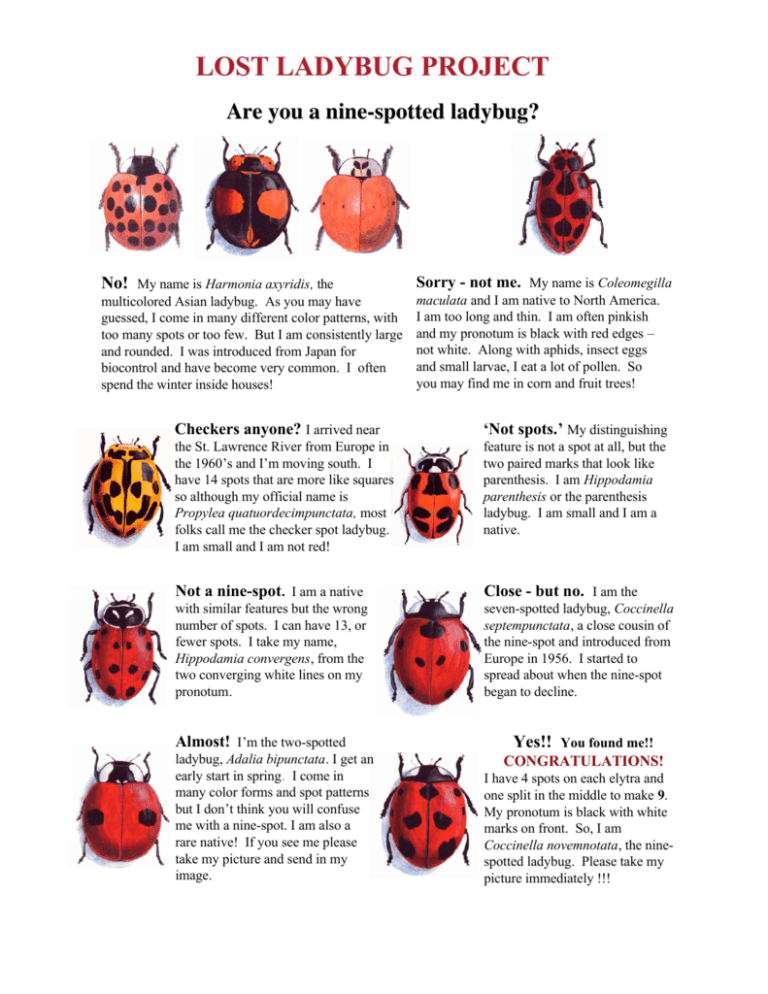
LOST LADYBUG PROJECT Are you a nine-spotted ladybug? No! My name is Harmonia axyridis, the multicolored Asian ladybug. As you may have guessed, I come in many different color patterns, with too many spots or too few. But I am consistently large and rounded. I was introduced from Japan for biocontrol and have become very common. I often spend the winter inside houses! Sorry - not me. My name is Coleomegilla maculata and I am native to North America. I am too long and thin. I am often pinkish and my pronotum is black with red edges – not white. Along with aphids, insect eggs and small larvae, I eat a lot of pollen. So you may find me in corn and fruit trees! Checkers anyone? I arrived near ‘Not spots.’ My distinguishing the St. Lawrence River from Europe in the 1960’s and I’m moving south. I have 14 spots that are more like squares so although my official name is Propylea quatuordecimpunctata, most folks call me the checker spot ladybug. I am small and I am not red! feature is not a spot at all, but the two paired marks that look like parenthesis. I am Hippodamia parenthesis or the parenthesis ladybug. I am small and I am a native. Not a nine-spot. I am a native Close - but no. I am the with similar features but the wrong number of spots. I can have 13, or fewer spots. I take my name, Hippodamia convergens, from the two converging white lines on my pronotum. seven-spotted ladybug, Coccinella septempunctata, a close cousin of the nine-spot and introduced from Europe in 1956. I started to spread about when the nine-spot began to decline. Almost! I’m the two-spotted ladybug, Adalia bipunctata. I get an early start in spring. I come in many color forms and spot patterns but I don’t think you will confuse me with a nine-spot. I am also a rare native! If you see me please take my picture and send in my image. Yes!! You found me!! CONGRATULATIONS! I have 4 spots on each elytra and one split in the middle to make 9. My pronotum is black with white marks on front. So, I am Coccinella novemnotata, the ninespotted ladybug. Please take my picture immediately !!! LOOKING FOR LOST LADYBUGS New York’s Honored State Insect The nine-spotted ladybug, Coccinella novemnotata (C-9) was once so common in New York and so respected for the great job it did controlling pests that, in 1985, it was proposed as the state insect by a fourth grade student. Unfortunately, by the time C-9 was honored in 1989 a precipitous population decline had already begun. There had been no confirmed collections of this ladybug in the eastern US since 1992 until one was found by Jilene (age 11) and Jonathon (age 10) Penhale (identified by Jordan Perlman) in 2006. This gave experts a place to start hunting! There may be a rare ladybug in your back yard right now! A Connecticut Yankee in Latvian Hearts What do Latvia and Connecticut have in common? They both chose the two-spotted lady beetle, Adalia bipunctata, as their official symbol. This beetle is considered native to North America and to Europe. Although this beetle is still occasionally collected in the Northeast, it is rapidly declining and we fear it may soon be gone from large portions of its former range. Some believe ladybugs were given their name in Europe after the red robes of the Virgin Mary (“Our Lady”) or because farmers believed they were sent by her to deliver them from the ravages of pests. The “Beetles of Our Lady” became “Lady Beetles”. In Latvia the two-spotted ladybug is called ‘marite’ after the Latvian goddess Mara, who embodies earth’s power. Unanswered Questions? Were these key components of our local ecosystems displaced by other lady bugs introduced to control pests? How will the loss of native predators affect the control of agricultural pests? Can they be reestablished like the wolves of Yellowstone? What can we learn from the demise of the nine-spotted and the two-spotted ladybugs that will help us to prevent the loss of other species? We need YOU to be collectors and photographers! Citizen scientists! Scientists need detailed information on which species are still out there and how many individuals can be found. We need you to be our legs, hands and eyes.!! Here’s how it will work: 1. Go out and look for ladybugs. The best time to look will be between May and October. Ladybugs can be found wherever there are aphids and small soft-bodied insects. Some are more common on low vegetation, small grains and legumes. Other species are also found in fruit trees and willows. Many overwinter in groups in leaf litter or by buildings. (Check our website for instructions on how to make your own sweep net!) 2. If you find any ladybugs - Take pictures of THEM ALL!! But first CHILL OUT! Your ladybug will be too active to get a good image unless you slow it down a little. You can do this in a freezer safely for 5 minutes (over 6 may kill them) and this will quiet them for 2-4 minutes. Coolers are not as cold as freezers so it will take 30+ minutes to get 1-6 minutes of quiet time. They will survive for days in a chilled cooler. PHOTO HINTS: Place your chilled-out ladybug on a gray background and take the largest shot you can while maintaining focus. Glare or reflection off the ladybug is often more of a problem than not having enough light. Shield the ladybug from bright light and use the flash only if there is very little light. 3. Note the date, time, location, and habitat (for example, garden, wild field, corn field). 4. Send this info along with digital images to ladybug@cornell.edu, or snapshots to: Lost Ladybug Project, Department of Entomology, Cornell University, Ithaca, NY 14853. 5. Please bring the ladybugs safely back to the place where you found them! Find more information and kids activities at: http://ladybug.ento.cornell.edu Funded by the National Science Foundation
